Can You Use Tattoo Ink To Dye Clothes? Absolutely, you can use tattoo ink to dye clothes, but it’s not the most practical or cost-effective method. Tattoo ink, known for its vibrant colors and permanence on skin, can technically transfer its pigment to fabric. However, the process isn’t straightforward, and the results may vary significantly compared to traditional fabric dyes. This comprehensive guide by tattooat.com will explore the possibilities, challenges, and best practices for using tattoo ink as a fabric dye, ensuring you have all the information you need before attempting this unique dyeing technique. We will also cover alternative fabric dyes and their specific benefits and drawbacks, including safety and environmental considerations for eco-conscious art.
1. Understanding Tattoo Ink and Its Properties
1.1 What Is Tattoo Ink Made Of?
Tattoo ink comprises pigments combined with a carrier solution. The pigments give the ink its color, while the carrier solution keeps the pigment evenly distributed and allows it to be applied to the skin. Common pigments include:
- Carbon Black: For black tattoos.
- Titanium Dioxide: For white tattoos.
- Azo Dyes: For various colors, though some may be controversial due to potential health concerns.
- Metal Salts: Such as iron oxides for reds and yellows.
The carrier solution typically consists of water, alcohol, glycerin, or witch hazel. Understanding these components is crucial when considering tattoo ink for dyeing clothes.
1.2 How Is Tattoo Ink Different From Fabric Dye?
The key difference lies in their formulation and intended use. Fabric dyes are designed to bond with textile fibers, providing long-lasting, even color. They often contain chemicals that facilitate this bonding process. Tattoo ink, on the other hand, is formulated to be deposited into the dermis layer of the skin, where it remains visible but doesn’t necessarily bond with the surrounding tissue in the same way a fabric dye bonds with fibers.
| Feature | Tattoo Ink | Fabric Dye |
|---|---|---|
| Purpose | To create permanent designs on skin | To permanently color fabric fibers |
| Pigment Type | Various, including carbon, metal salts | Azo dyes, natural dyes, reactive dyes |
| Carrier | Water, alcohol, glycerin, witch hazel | Water, solvents, or specialized dye carriers |
| Bonding | Designed to remain in the dermis | Designed to bond with fabric fibers |
| Permanence | Long-lasting on skin | Long-lasting on fabric |
1.3 Is Tattoo Ink Safe to Use on Fabrics?
Tattoo ink is generally considered safe for use on skin, but its safety on fabrics is less studied. Some pigments, particularly azo dyes, have raised concerns about potential carcinogenicity. When using tattoo ink on clothing, ensure the fabric is thoroughly washed to remove any excess ink and reduce the risk of skin irritation. Always check the specific ink’s Material Safety Data Sheet (MSDS) for detailed safety information.
2. The Feasibility of Dyeing Clothes With Tattoo Ink
2.1 Can Tattoo Ink Permanently Dye Fabric?
Yes, tattoo ink can permanently dye fabric to some extent, but the permanence and vibrancy may not match those achieved with professional fabric dyes. Tattoo ink is designed to be long-lasting in the skin, which means the pigments are stable and resistant to fading. However, without the proper bonding agents found in fabric dyes, tattoo ink may fade or bleed over time, especially with repeated washing.
2.2 What Types of Fabrics Work Best With Tattoo Ink?
Natural fabrics like cotton, linen, and silk tend to work best with tattoo ink because they are more porous and absorbent than synthetic fabrics. These materials allow the ink to penetrate the fibers more effectively. Synthetic fabrics like polyester and nylon may not absorb the ink as well, resulting in a less vibrant and less permanent color.
2.3 What Colors of Tattoo Ink Are Most Effective for Dyeing?
Darker colors like black, blue, and green typically yield the best results when dyeing fabric with tattoo ink. These colors are more concentrated and provide better coverage than lighter colors like yellow or white. Additionally, darker inks are more resistant to fading, ensuring the dyed fabric retains its color for a longer period.
3. Step-by-Step Guide: Dyeing Clothes With Tattoo Ink
3.1 Materials Needed
- Tattoo ink (desired colors)
- White or light-colored fabric (natural fibers like cotton or linen)
- Spray bottle with water
- Ziploc bag or container
- Pipettes or small applicators
- Gloves
- Iron
3.2 Preparing the Fabric
- Wash the Fabric: Start by washing the fabric to remove any sizing or finishes that may prevent the ink from adhering properly.
- Moisten the Fabric: Lightly dampen the fabric with water using a spray bottle. The moisture helps the ink to spread evenly and penetrate the fibers.
3.3 Applying the Tattoo Ink
- Place Fabric in a Bag: Put the moistened fabric inside a Ziploc bag or container to contain the ink and prevent it from spreading.
- Add Ink: Use pipettes or small applicators to apply the tattoo ink to the fabric. You can apply one color at a time to create a multi-colored effect, or mix colors beforehand for a more uniform shade.
- Scrunch and Massage: Gently scrunch and massage the fabric to ensure the ink is evenly distributed. This helps the ink penetrate all areas of the fabric.
3.4 Drying and Setting the Ink
- Remove From Bag: Once you are satisfied with the color distribution, remove the fabric from the bag.
- Air Dry: Allow the fabric to air dry completely. This may take several hours or even overnight.
- Iron the Fabric: After the fabric is dry, iron it on a high setting to help set the ink. The heat helps to bond the ink to the fibers, making the color more permanent.
3.5 Washing and Caring for Dyed Fabric
- Hand Wash: Hand wash the dyed fabric in cold water with a mild detergent. Avoid using harsh chemicals or bleach, as these can cause the ink to fade.
- Avoid Over-Washing: Wash the fabric only when necessary to prolong the life of the color.
- Dry Inside Out: When drying, turn the fabric inside out to prevent fading from sunlight.
4. Creative Techniques for Using Tattoo Ink on Clothes
4.1 Tie-Dye Effects
Create tie-dye effects by twisting, folding, and tying the fabric before applying the tattoo ink. Use rubber bands or string to secure the fabric in various patterns, then apply different colors of ink to the exposed areas. This technique results in unique, vibrant designs.
4.2 Ombre Effects
Achieve an ombre effect by gradually applying different shades of tattoo ink to the fabric. Start with a lighter shade at one end and gradually darken the color as you move towards the other end. Blend the colors seamlessly for a smooth transition.
4.3 Stencil Designs
Use stencils to create precise designs on your fabric. Cut out the desired shape from a piece of cardboard or plastic, place it on the fabric, and apply the tattoo ink using a sponge or brush. This technique is perfect for creating intricate patterns and logos.
5. Challenges and Limitations of Using Tattoo Ink
5.1 Color Fading and Bleeding
One of the main challenges of using tattoo ink to dye clothes is the potential for color fading and bleeding. Unlike fabric dyes, tattoo ink is not specifically formulated to bond with textile fibers, so it may not be as permanent. Over time, the color may fade with repeated washing, or the ink may bleed onto other areas of the fabric.
5.2 Uneven Color Distribution
Achieving even color distribution can also be difficult with tattoo ink. Because the ink is applied manually, it can be challenging to ensure that all areas of the fabric are evenly saturated. This can result in a patchy or uneven appearance.
5.3 Cost Considerations
Tattoo ink can be quite expensive, especially if you are dyeing a large piece of fabric. The cost of the ink may outweigh the benefits, especially when compared to traditional fabric dyes, which are typically more affordable.
6. Alternative Fabric Dyes
6.1 Traditional Fabric Dyes
Traditional fabric dyes are specifically designed to bond with textile fibers, providing long-lasting, even color. These dyes are available in a wide range of colors and formulations, including:
- Fiber Reactive Dyes: For cotton, linen, and other plant-based fabrics.
- Acid Dyes: For wool, silk, and other protein-based fabrics.
- Disperse Dyes: For polyester and other synthetic fabrics.
6.2 Natural Dyes
Natural dyes are derived from plants, animals, and minerals. They are an eco-friendly alternative to synthetic dyes and can produce beautiful, unique colors. Common natural dyes include:
- Indigo: From the indigo plant, for blue shades.
- Madder: From the madder root, for red shades.
- Turmeric: From the turmeric root, for yellow shades.
6.3 Tie Dye Kits
Tie dye kits offer a convenient way to dye fabric with vibrant colors and unique patterns. These kits typically include pre-mixed dyes, rubber bands, and instructions for creating various tie dye effects.
7. Safety and Environmental Considerations
7.1 Potential Health Risks
Some tattoo inks contain pigments that have raised health concerns, particularly azo dyes, which have been linked to potential carcinogenicity. When using tattoo ink on clothing, it is important to take precautions to minimize your exposure to these chemicals. Wear gloves during the dyeing process, and wash the fabric thoroughly after dyeing to remove any excess ink.
7.2 Environmental Impact
The production and disposal of synthetic dyes can have a significant environmental impact. Many synthetic dyes are derived from petroleum and can release harmful chemicals into the environment during manufacturing. Additionally, the wastewater from dyeing processes can pollute rivers and streams.
7.3 Eco-Friendly Alternatives
Consider using natural dyes or low-impact synthetic dyes to minimize the environmental impact of your dyeing projects. Natural dyes are derived from renewable resources and are biodegradable, making them a more sustainable choice. Low-impact synthetic dyes are formulated to use fewer chemicals and less water during the dyeing process, reducing their environmental footprint.
8. Expert Opinions on Using Tattoo Ink for Dyeing
8.1 Insights From Tattoo Artists
Many tattoo artists advise against using tattoo ink for dyeing clothes due to the cost and the potential for uneven results. They emphasize that tattoo ink is specifically formulated for use on skin and may not perform as well on fabric. However, some artists acknowledge that it can be a fun and creative experiment for small projects.
8.2 Textile Experts’ Views
Textile experts generally recommend using traditional fabric dyes for dyeing clothes, as these dyes are designed to bond with textile fibers and provide long-lasting, even color. They caution that tattoo ink may not be as permanent or vibrant as fabric dyes and may fade or bleed over time.
9. Showcasing Successful Projects
9.1 Examples of Tattoo Ink-Dyed Clothing
Despite the challenges, some individuals have successfully used tattoo ink to dye clothing and create unique designs. These projects often involve small items like t-shirts, scarves, or patches, where the limited coverage and potential for fading are less of a concern.
9.2 Tips for Replication
If you are inspired to try dyeing clothes with tattoo ink, here are a few tips for replicating successful projects:
- Start Small: Begin with a small item or a test swatch to get a feel for the process.
- Use Dark Colors: Choose dark colors like black, blue, or green for the best coverage and color retention.
- Apply Evenly: Take your time to apply the ink evenly and ensure all areas of the fabric are saturated.
- Set the Ink: Iron the fabric after dyeing to help set the ink and make the color more permanent.
10. FAQs About Using Tattoo Ink to Dye Clothes
10.1 Can You Use Expired Tattoo Ink To Dye Clothes?
Yes, you can use expired tattoo ink to dye clothes, but be aware that the color may not be as vibrant or long-lasting. Expired ink may have degraded pigments, leading to less effective dyeing.
10.2 Does Tattoo Ink Wash Out of Clothes?
Tattoo ink can wash out of clothes to some extent, especially if it is not properly set. Hand washing in cold water and avoiding harsh detergents can help prolong the life of the color.
10.3 Is Tattoo Ink Toxic to Fabric?
Tattoo ink is not typically toxic to fabric, but some pigments may contain chemicals that can irritate the skin. Always wash the dyed fabric thoroughly before wearing it.
10.4 How Long Does Tattoo Ink Last on Fabric?
The longevity of tattoo ink on fabric depends on several factors, including the type of ink, the type of fabric, and the washing and care routine. With proper care, the color can last for several months or even years.
10.5 Can You Mix Tattoo Ink With Fabric Dye?
Mixing tattoo ink with fabric dye is not generally recommended, as the two substances are formulated differently and may not bond properly. This can result in unpredictable color and reduced permanence.
10.6 Will Tattoo Ink Stain My Washing Machine?
Tattoo ink can stain your washing machine if excess ink is released during the wash cycle. To prevent this, hand wash the dyed fabric separately for the first few washes.
10.7 Can I Use Tattoo Ink on All Types of Fabric?
No, tattoo ink works best on natural fabrics like cotton, linen, and silk. Synthetic fabrics like polyester and nylon may not absorb the ink as well.
10.8 How Can I Make Tattoo Ink More Permanent on Fabric?
Ironing the fabric after dyeing and using a fabric sealant can help make tattoo ink more permanent. Additionally, avoiding harsh detergents and over-washing can prolong the life of the color.
10.9 Is It Safe to Wear Clothes Dyed With Tattoo Ink?
It is generally safe to wear clothes dyed with tattoo ink, but it is important to wash the fabric thoroughly to remove any excess ink and reduce the risk of skin irritation.
10.10 What Are the Best Brands of Tattoo Ink for Dyeing Clothes?
Some popular brands of tattoo ink that are often used for dyeing clothes include Intenze, Eternal Ink, and Starbrite. These brands are known for their vibrant colors and high-quality pigments.
Conclusion
While you can use tattoo ink to dye clothes, it’s essential to weigh the pros and cons carefully. The vibrant colors and permanence of tattoo ink are appealing, but the cost, potential for fading, and uneven distribution can be significant drawbacks. For those looking for reliable and lasting results, traditional or natural fabric dyes are generally a better option.
Ready to explore more about tattoo art and find inspiration for your next project? Visit tattooat.com today to discover a wealth of designs, connect with talented artists, and learn everything you need to know about the world of tattooing. Whether you’re considering a new tattoo or experimenting with DIY fabric dyeing, tattooat.com is your ultimate resource.
Address: 1825 SW Broadway, Portland, OR 97201, United States
Phone: +1 (503) 725-3000
Website: tattooat.com
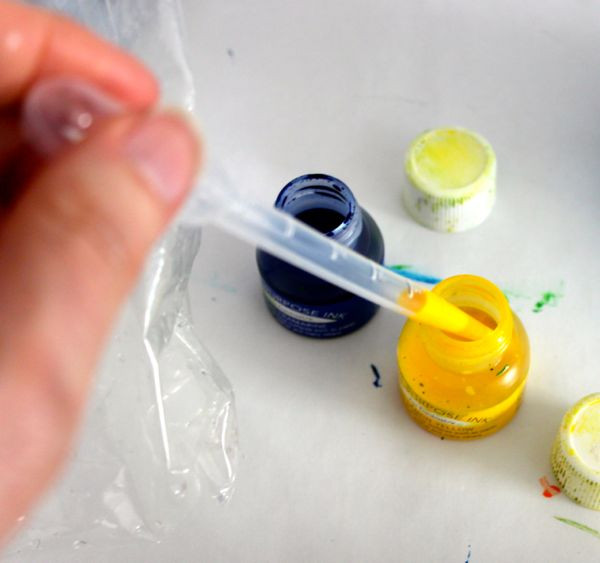 Hand holding a bottle of blue tattoo ink
Hand holding a bottle of blue tattoo ink
Image: A close-up shot showcasing a hand holding a bottle of vibrant blue tattoo ink, emphasizing the color intensity and potential for creative fabric dyeing projects.
 Spraying water onto white fabric for ink dyeing
Spraying water onto white fabric for ink dyeing
Image: Preparing white fabric by spraying it with water, an essential step in the tattoo ink dyeing process to ensure even distribution and absorption of the dye.
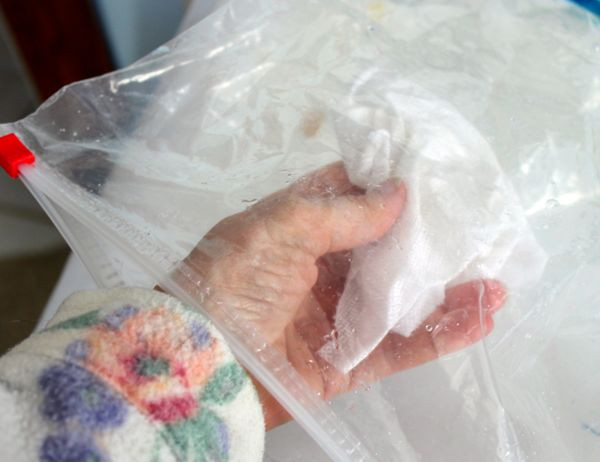 Fabric inside a ziploc bag during the dyeing process with tattoo ink
Fabric inside a ziploc bag during the dyeing process with tattoo ink
Image: A fabric sample enclosed in a ziplock bag during the dyeing procedure, demonstrating the containment method used when working with tattoo ink on textiles.
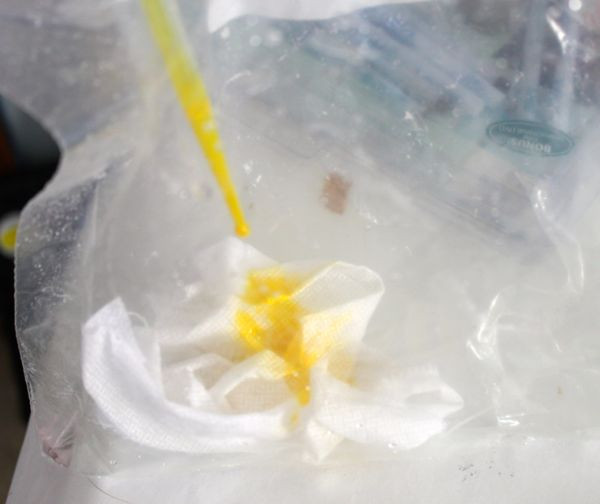 Adding colored tattoo ink to wet fabric
Adding colored tattoo ink to wet fabric
Image: Demonstrating the controlled application of colored tattoo ink onto pre-wetted fabric, highlighting the precision required for achieving desired color saturation and design.
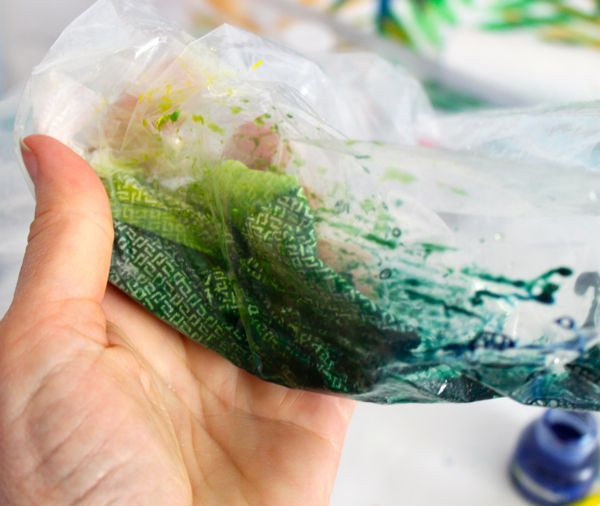 Scrunching fabric to distribute tattoo ink evenly
Scrunching fabric to distribute tattoo ink evenly
Image: A close-up view of fabric being scrunched by hand, illustrating the technique used to evenly distribute tattoo ink across the textile during the dyeing process.
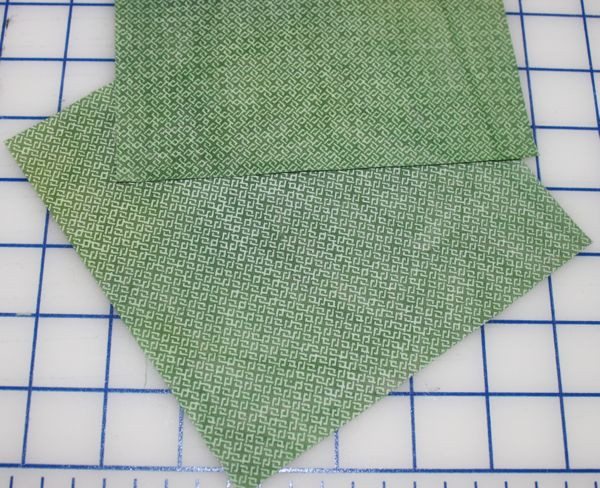 Dyed fabric with ink showcasing color intensity
Dyed fabric with ink showcasing color intensity
Image: Displaying a sample of fabric successfully dyed with tattoo ink, showcasing the achieved color intensity and texture after the dyeing process.
